Next-generation Computing Market Size
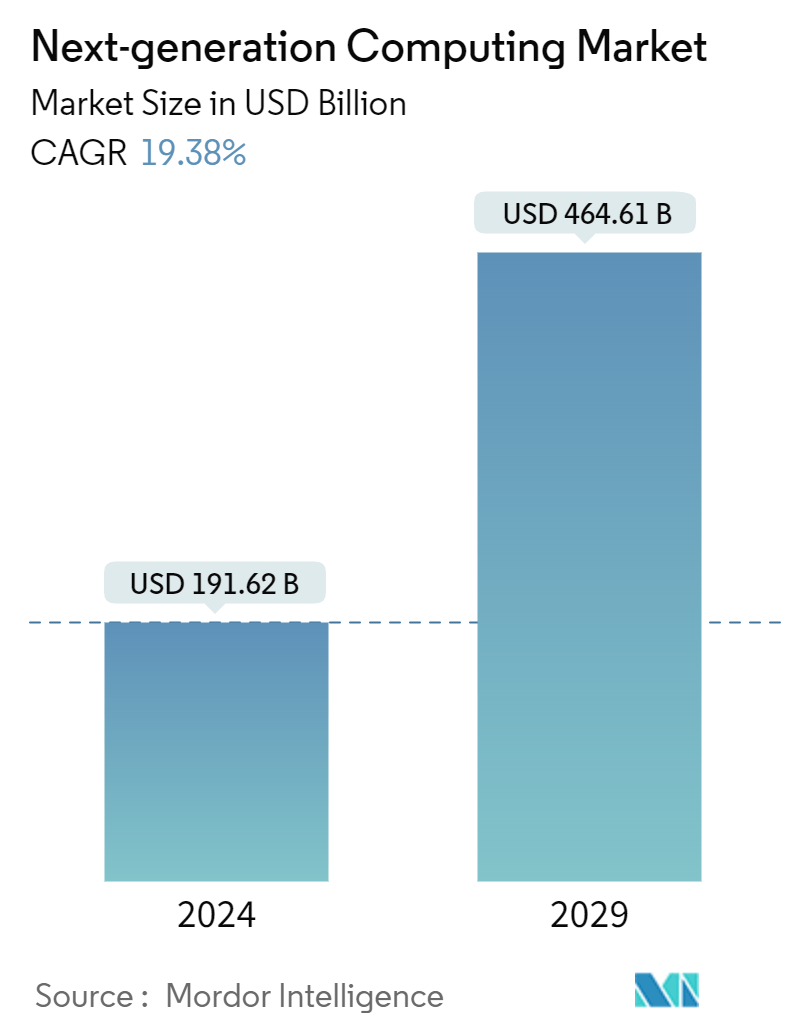
| Study Period | 2019 - 2029 |
| Market Size (2024) | USD 191.62 Billion |
| Market Size (2029) | USD 464.61 Billion |
| CAGR (2024 - 2029) | 19.38 % |
| Fastest Growing Market | Asia Pacific |
| Largest Market | North America |
Major Players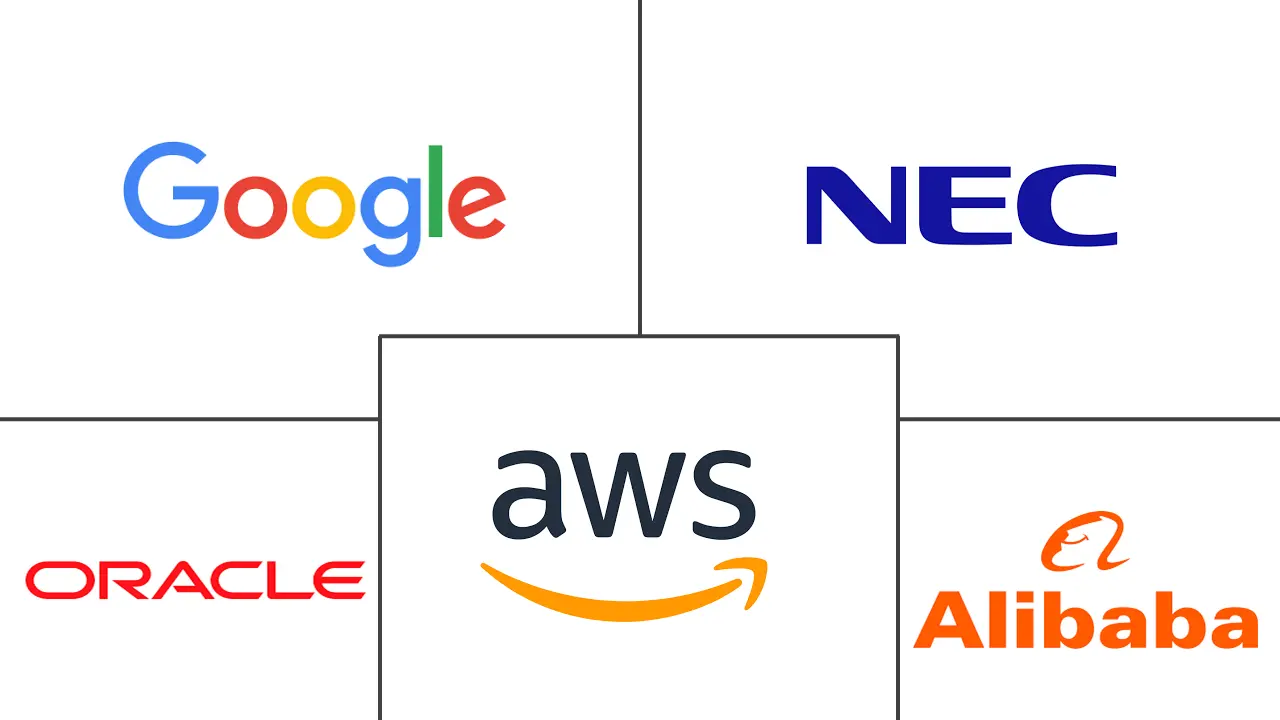
*Disclaimer: Major Players sorted in no particular order |
Next-generation Computing Market Analysis
The Next-generation Computing Market size is estimated at USD 191.62 billion in 2024, and is expected to reach USD 464.61 billion by 2029, growing at a CAGR of 19.38% during the forecast period (2024-2029).
Implementing Next-generation computing solutions gives end users a shorter lead time in product development, flexibility, process efficiencies, enhanced productivity, higher quality, more intuitive customer experiences, and improved profitability, fueling market adoption worldwide.
- Next-generation computing market is evolving from the emergence of new technologies such as Distributed computing, Machine learning, Artificial intelligence, and Cloud computing for efficient computing by using centralizing storage, memory, processing, and bandwidth, driving the market in various end-user applications.
- The demand for High-performance computing is increasing and becoming crucial for organizations as it enables them to compute and analyze large volumes of data quickly and efficiently, which is significantly essential in scientific research, engineering, and finance, where the ability to process large amounts of data to give insights for better operational efficiencies and customer services. The need for next-gen computing solutions for High-performance computing applications drives the market.
- Additionally, with better supply chain management, increased productivity, and streamlined operations, SMEs have benefited from digital transformation. SMEs have been automating their processes and reducing costs using cloud computing, AI, and blockchain, which would drive the market during the forecast period. For instance, in December 2022, UST, a digital transformation solutions provider, announced a collaboration with Intel and SAP to enable the Industry 4.0 digital transformation journey for small and medium-sized enterprises in northern Malaysia, creating an opportunity for the market vendors due to their next-gen computing solutions for Industry 4.0.
- However, the next-gen solutions and computing technology involve processing & data shared between local devices, mobile devices, cloud-based servers, etc., which generates a threat of data privacy risk in the end users while implementing the solutions for their business processes, which could restrict the market adoption in many end-users, such as defense, BFSIs, etc. during the forecast period.
Next-generation Computing Market Trends
The Cloud Deployment of The Solutions Significantly Contributes to The Market Growth
- The adoption of cloud-based computing solutions is gaining traction in all end-users, including large and small-scale enterprises worldwide, due to its benefits such as Cost Savings, Security, Flexibility, Mobility, Increased Collaboration, Easy Disaster Recovery & Loss Prevention, Automatic Software Updates, etc., which is fueling the adoption of cloud-based next-generation computing solutions in the market.
- The enterprises in developed and developing economies, with the help of their countries' government investment in ICT infrastructure, are adopting cloud-based software, supporting the growth of the cloud-based next-generation computing solution market during the forecast period. For instance, in November 2022, Amazon Web Services, in partnership with the Dubai Chamber of Digital Economy, published a report stating that hyper-scale cloud computing solutions, which include scalable cloud storage, services, and computing capabilities, are expected to provide SMEs and startups in the UAE with USD 17.1 billion worth of economic benefits from 2022 and 2030.
- Market vendors such as Microsoft, Amazon, IBM, and Google have been investing significantly in quantum computing and partnering to offer SaaS models to their cloud-based quantum computers, enabling the technology to be accessible to mainstream enterprises, which can be shared among many companies. They can be used as a Pay-as-Use model, driving the Cloud-enabled next-generation computing solutions market.
- For instance, in March 2023, HCL Technologies partnered with Microsoft's quantum cloud computing service, Azure Quantum, to offer businesses cloud-based quantum computing services to clients using Microsoft's platform as the technology stack. The benefits would be provided through HCLTech's Q-Labs, which has already been among one of Microsoft's partners to offer Azure Quantum credits.
- Additionally, cloud-based quantum computing providers have been helping in advising the need to use quantum computing effectively and supporting the enterprise's adoption of cloud-based services through collaboration with other organizations in the field of quantum computing. For instance, IBM has developed IBM's Q Network, a global partnership of organizations working together in advanced quantum computing and exploring its potential applications, supporting the adoption of cloud-based next-generation computing in the market.
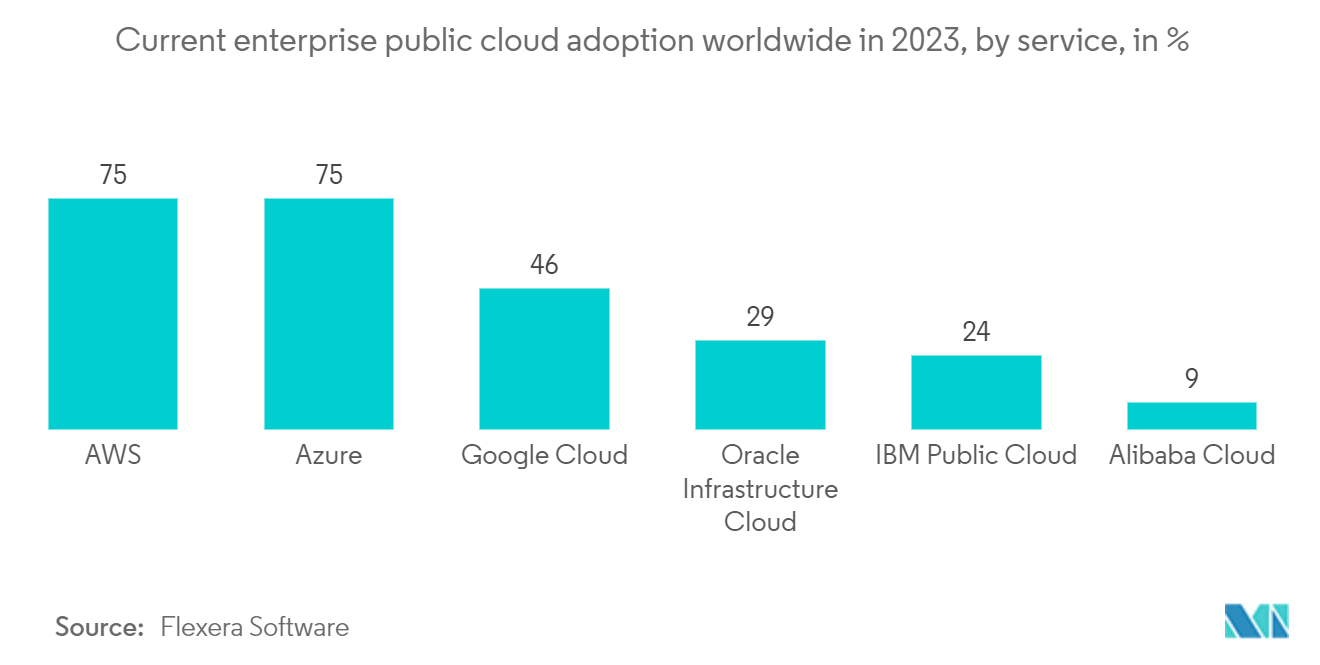
The Asia-pacific Region is Registering The Highest Market Growth
- The Asia-Pacific region has many emerging economies, including India, China, Japan, South Korea, etc., adopting digitalization solutions in their countries. The digitalization in various end users, such as Healthcare, Automotive & Transportation, BFSIs, IT & Telecom, etc., in the countries are creating an opportunity for the market vendors of next-generation computing solution providers due to the need for AI & ML based Computing in increasing the productivity of the enterprises.
- For instance, in June 2023, Beyond Limits, a leading enterprise-grade artificial intelligence (AI) software company, signed a Memorandum of Understanding with IQM Quantum Computers, a company in building quantum computers, to drive the advancement of quantum AI technology in the Asia-pacific region, which shows the demand for quantum Computing in the area, fueling the market in APAC region during the forecast period.
- The adoption of online services in small and large-scale enterprises, including the hospitals in the APAC region, generates a significant amount of business data, which drives the requirement for Next-generation computing solutions to enable the enterprises to have business insights from those data. For instance, in November 2022, Manipal Hospitals Group of India partnered with Google Cloud to improve patient care experiences and the hospital chain's network efficiency. It would use Google Cloud's conversational AI-based solution to enhance customer interactions by offering all-time patient care.
- In addition, Singapore, Malaysia, and Indonesia have constructed many large data centers, which would support the growth of Next-generation computing in large-scale industrial enterprises within the APAC region because adopting these solutions, majorly the cloud-based next-generation computing solutions, would require Data centers to store the enterprise data for Computing.
- For instance, in July 2023, Equinix, GDS, Microsoft, and a consortium of AirTrunk and TikTok-owner ByteDance were selected to operate the Singapore-based 80 MW data center by the Singapore Economic Development Board and the Infocomm Media Development Authority, which would support the adoption of next-generation computing solutions in the APAC region.
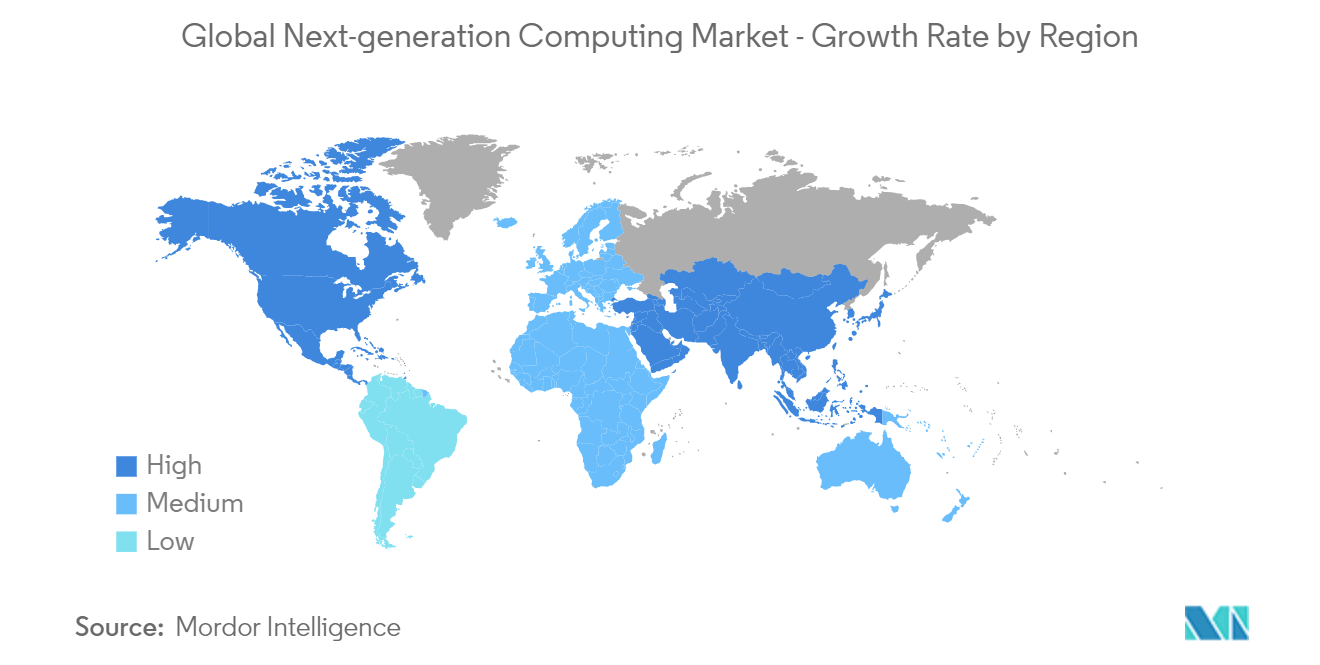
Next-generation Computing Industry Overview
The Global Next-generation Computing Market is highly fragmented due to many global companies, such as Alibaba Group Holding Limited, Amazon Web Services Inc, Oracle Corporation, Google LLC, and NEC Corporation, contributing to the overall market share. Next-generation Computing Market vendors increasingly focus on delivering enhanced solutions through product innovations, collaborations, and investment in R&D to increase their market presence during the forecast period.
In June 2023, Google Llc partnered with T-Mobile to empower 5G and edge computing capabilities, enabling enterprises to increase their digital transformation. After this partnership, T-Mobile would connect the 5G ANS suite of public, private, and hybrid 5G networks with Google Distributed Cloud Edge (GDC Edge) to help customers have next-generation 5G applications such as AR/VR experiences.
Next-generation Computing Market Leaders
-
Alibaba Group Holding Limited
-
Amazon Web Services, Inc
-
Oracle Corporation
-
Google LLC
-
NEC Corporation
*Disclaimer: Major Players sorted in no particular order
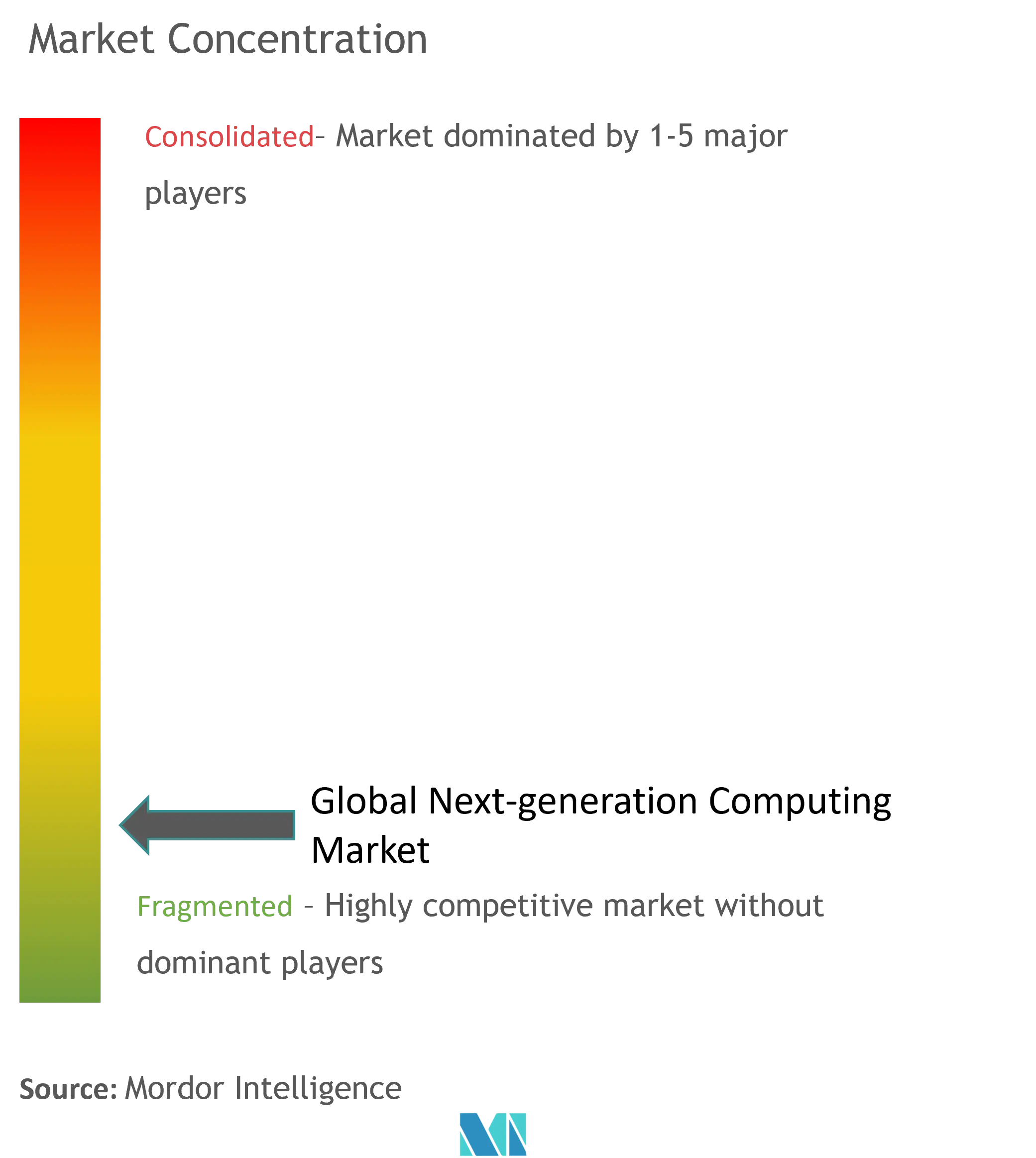
Next-generation Computing Market News
- July 2023: Moody's and Microsoft have partnered strategically to co-create next-generation data, analytics, research, collaboration, and risk solutions for financial services, which would be built by combining Microsoft's Azure OpenAI Service, Fabric, and Teams with Moody's proprietary data, analytics, and research and has been designed to enhance insights into corporate intelligence and risk assessment.
- September 2022: General Atomics Aeronautical Systems, an American manufacturer of Ariel vehicles, has announced a strategic partnership with an Indian start-up company, 3rdiTech, to develop next-gen integrated circuits, other semiconductor technologies, and computer chips that would fuel the market in the forecast period.
Next-generation Computing Market Report - Table of Contents
1. INTRODUCTION
- 1.1 Study Assumptions and Market Definition
- 1.2 Scope of the Study
2. RESEARCH METHODOLOGY
3. EXECUTIVE SUMMARY
4. MARKET INSIGHTS
- 4.1 Market Overview
-
4.2 Industry Attractiveness - Porter's Five Forces Analysis
- 4.2.1 Bargaining Power of Suppliers
- 4.2.2 Bargaining Power of Buyers
- 4.2.3 Threat of New Entrants
- 4.2.4 Threat of Substitutes
- 4.2.5 Intensity of Competitive Rivalry
- 4.3 Industry Value Chain Analysis
- 4.4 Assessment of the Impact of COVID-19 on the Market
5. MARKET DYNAMICS
-
5.1 Market Drivers
- 5.1.1 Growth in demand for high performance computing
- 5.1.2 Adoption of Advanced Analytics in SMEs
-
5.2 Market Restraints
- 5.2.1 Risk of Data Breach in Storing and Processing Large Data in Next-gen Computing
- 5.2.2 High operational challenges in Implementing the Solution
6. MARKET SEGMENTATION
-
6.1 By Component
- 6.1.1 Hardware
- 6.1.2 Software
- 6.1.3 Services
-
6.2 By Computing Type
- 6.2.1 High-Performance Computing
- 6.2.2 Quantum Computing
- 6.2.3 Optical Computing
- 6.2.4 Edge Computing
- 6.2.5 Other Computing Types
-
6.3 By Deployement
- 6.3.1 Cloud
- 6.3.2 On-Premise
-
6.4 By End-user
- 6.4.1 Automotive & Transportation
- 6.4.2 Energy & Utilities
- 6.4.3 Healthcare
- 6.4.4 BFSI
- 6.4.5 Aerospace & Defense
- 6.4.6 Media & Entertainment
- 6.4.7 IT & Telecom
- 6.4.8 Retail
- 6.4.9 Manufacturing
- 6.4.10 Other End Users
-
6.5 By Geography***
- 6.5.1 North America
- 6.5.2 Europe
- 6.5.3 Asia
- 6.5.4 Australia and New Zealand
- 6.5.5 Latin America
- 6.5.6 Middle East and Africa
7. COMPETITIVE LANDSCAPE
-
7.1 Company Profiles
- 7.1.1 Alibaba Group Holding Limited
- 7.1.2 Amazon Web Services, Inc
- 7.1.3 Oracle Corporation
- 7.1.4 Google LLC
- 7.1.5 NEC Corporation
- 7.1.6 Cisco Systems
- 7.1.7 Intel Corporation
- 7.1.8 IBM Corporation
- 7.1.9 Microsoft Corporation
- 7.1.10 NVIDIA Corp
- *List Not Exhaustive
- 7.2 * List not exhaustive
8. INVESTMENT ANALYSIS
9. MARKET OPPORTUNITIES AND FUTURE TRENDS
** Subject To AvailablityNext-generation Computing Industry Segmentation
Global Next-generation Computing Market can be defined as computing solutions offered by the market vendors using advanced processors and AI & ML enabled software for managing, storing, and processing data automatically for high-power computational needs in the end-users, which are replacing older CPUs with newer chip architectures, such as GPUs and field-programmable gate arrays (FPGAs).
Global Next-generation Computing Market is components (hardware, software, and services), computing type (high-performance computing, quantum computing, cloud computing, edge computing), deployment type (cloud, on-premise), end-user (automotive & transportation, energy & utilities, healthcare, BFSI, aerospace & defense, media & entertainment, IT & telecom, retail, manufacturing), and geography (North America, Europe, Asia-Pacific, Latin America, Middle East & Africa). The market sizes and forecasts are provided in terms of value in USD for all the above segments.
| By Component | Hardware |
| Software | |
| Services | |
| By Computing Type | High-Performance Computing |
| Quantum Computing | |
| Optical Computing | |
| Edge Computing | |
| Other Computing Types | |
| By Deployement | Cloud |
| On-Premise | |
| By End-user | Automotive & Transportation |
| Energy & Utilities | |
| Healthcare | |
| BFSI | |
| Aerospace & Defense | |
| Media & Entertainment | |
| IT & Telecom | |
| Retail | |
| Manufacturing | |
| Other End Users | |
| By Geography*** | North America |
| Europe | |
| Asia | |
| Australia and New Zealand | |
| Latin America | |
| Middle East and Africa |
Next-generation Computing Market Research Faqs
How big is the Next-generation Computing Market?
The Next-generation Computing Market size is expected to reach USD 191.62 billion in 2024 and grow at a CAGR of 19.38% to reach USD 464.61 billion by 2029.
What is the current Next-generation Computing Market size?
In 2024, the Next-generation Computing Market size is expected to reach USD 191.62 billion.
Who are the key players in Next-generation Computing Market?
Alibaba Group Holding Limited, Amazon Web Services, Inc, Oracle Corporation, Google LLC and NEC Corporation are the major companies operating in the Next-generation Computing Market.
Which is the fastest growing region in Next-generation Computing Market?
Asia Pacific is estimated to grow at the highest CAGR over the forecast period (2024-2029).
Which region has the biggest share in Next-generation Computing Market?
In 2024, the North America accounts for the largest market share in Next-generation Computing Market.
What years does this Next-generation Computing Market cover, and what was the market size in 2023?
In 2023, the Next-generation Computing Market size was estimated at USD 154.48 billion. The report covers the Next-generation Computing Market historical market size for years: 2019, 2020, 2021, 2022 and 2023. The report also forecasts the Next-generation Computing Market size for years: 2024, 2025, 2026, 2027, 2028 and 2029.
Next-generation Computing Industry Report
Statistics for the 2024 Next-generation Computing market share, size and revenue growth rate, created by Mordor Intelligence™ Industry Reports. Next-generation Computing analysis includes a market forecast outlook to for 2024 to 2029 and historical overview. Get a sample of this industry analysis as a free report PDF download.



